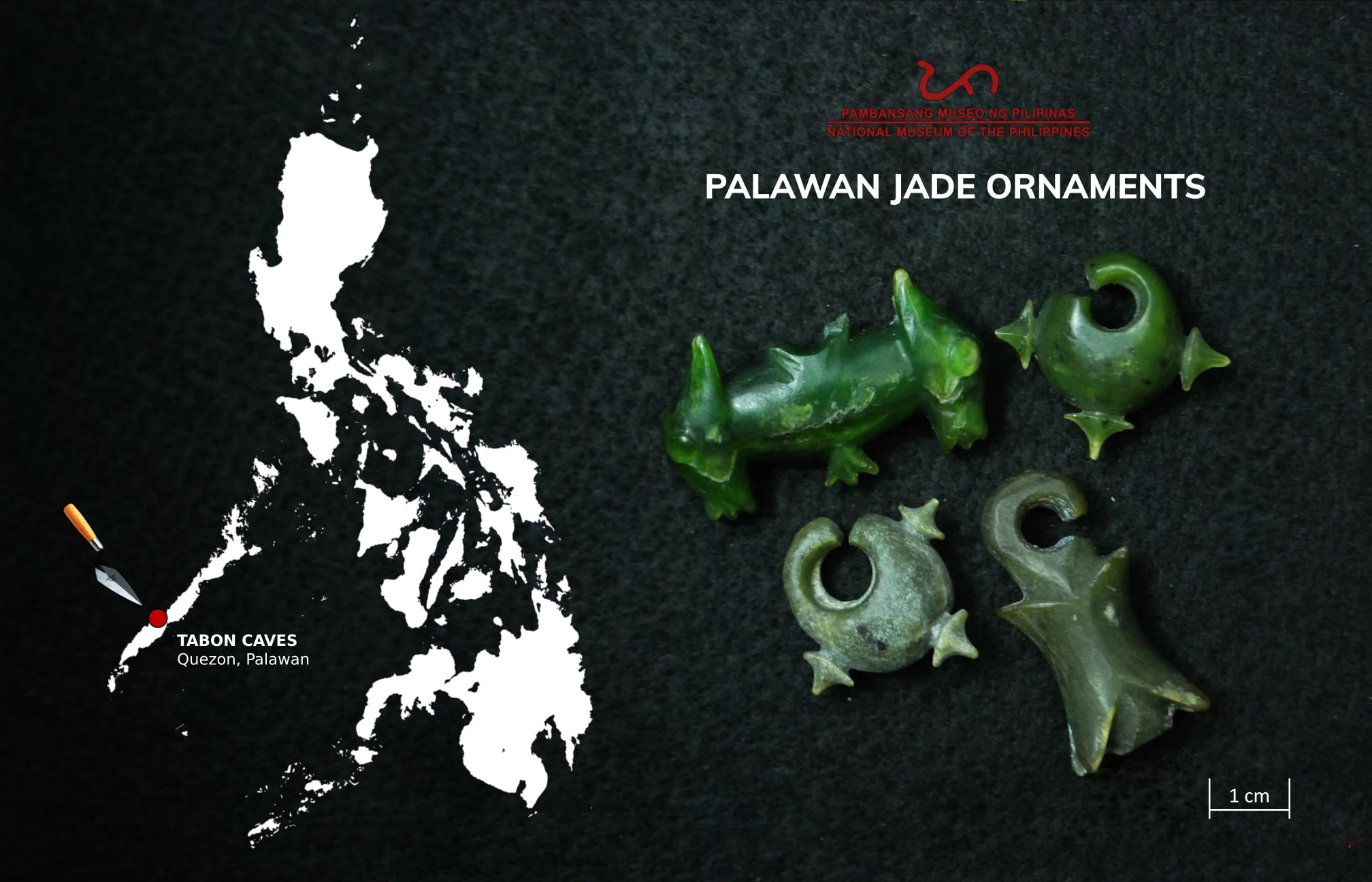Precious Palawan Jade Ornaments: The Zoomorphic Ear Pendant and Nephrite Lingling-o Ear Pendant [Philippines National Cultural Treasures]
Jade is a semi-precious stone that comes in a wide variety of colors, but commonly known in green. The English word “jade” was first used in the 16th century and is derived from the French term “pierre l’ejade”, or “le jade”, adopted from the Spanish piedra de ijada. The origin of the word can be attributed to a green stone—chalchiutl by the Aztecs—found by the Spaniards being used by Mesoamerican people. The term “piedra de ijada”, meaning “kidney stone”, originated from the belief in the stone’s curative properties, especially for the kidneys.
Between 1846 and 1881, French mineralogist Alexis Damour established the two distinct mineralogical types of jade: jadeite, of which most jade objects in Mesoamerica are made; and nephrite, which is more common in East Asia. The mineral name “nephrite” is derived from lapis nephriticus, which is the Latin version of piedra de ijada, while “jadeite” came from the English word “jade”.
These two mineral species show great resemblance in their appearances but can be distinguished from each other in the composition of silicate minerals, identifiable through chemical analysis, microscopic examination, and specific gravity. The only property common to both minerals is hardness. Even the generally known characteristic green color of jade varies greatly from each mineral due to differences in structure and composition (such as quantity and presence of other minerals).
For more than 8,000 years, nephrite jade has been one of the most valued gemstones in the Chinese culture, from which the oldest jade artifacts in Asia were found. A highly symbolic stone, jade was used for tools, ornaments, and ritual objects. By 3000 years Before Common Era (BCE), knowledge of jade-working was spreading throughout Taiwan, as the craft was at its peak at the Hongshan and Liangshu cultures of China. Dr. Yoshiyuki Iizuka and Dr. Hsiao-chun Hung’s scientific studies suggest that green nephrites found in the Philippines are of Fengtian nephrite, which originated from eastern Taiwan, and became widely distributed in Neolithic and Metal Age sites in Batanes, Cagayan, southern Luzon, and Palawan from about 2250 BCE to about 1000 Common Era or CE.
National Museum of the Philippines' archaeological work in Palawan during the 1960s led by Dr. Robert Fox represents the first series of scientific excavation in the history of Philippine archaeology. Explorations in the island particularly in Duyong and Uyaw Caves, yielded jade artifacts—ear ornaments, bracelets, beads, and small stud-like objects—considered as one of the finest jade ornaments ever recovered. More than 18 lingling-o ear ornaments of green jade were excavated in Duyong Cave alone, and 14 more in Uyaw Cave.
 |
| Different Lingling-o artifacts from Palawan: the Palawan Zoomorphic Ear Pendant (top-left), two Sa Hyunh type lingling-o, and the Palawan Nephrite Lingling-o Ear Pendant (lower right). |
The lingling-o artifacts found in the island are associated to the Early Metal Age (500–200 BCE) in the Philippines. As noted by Dr. Fox, the recovered lingling-o ornaments were of two kinds: (1) decorated with three studs in the form of lotus bud-like projections, similar to the “Sa Huynh type” specimens of southern Vietnam; and (2) decorated with four projections, similar to the “Hong Kong type” specimens found in Hong Kong.
In 2010, the NMP declared as NCTs two exceptional jade artifacts from the 1960s Palawan archaeological work: the Palawan Zoomorphic Ear Pendant, and the Palawan Nephrite Lingling-o Ear Pendant.
 |
| The Palawan Zoomorphic Ear Pendant was systematically recovered by archaeologists of the National Museum of the Philippines in 1966 at Duyong Cave Site in Palawan. |
Recovered in Duyong Cave in 1966, the Palawan Zoomorphic Ear Pendant which is 4.2 cm long and weighs 22 g, is a one-of-a-kind jade ornament displaying a double-headed zoomorphic (animal-like form) design. The Palawan Nephrite Lingling-o Ear Pendant from Uyaw Cave, measures 3 cm in length and 9 g in weight, and displays a projection of a stylized bud design resulting in a simple point with concave sides. These lingling-o artifacts’ distinctiveness serve as tangible evidences of the superb craftsmanship in prehistoric jade carving in Asia.
At present, the oldest jade artifact in the Philippines is a green nephrite bracelet fragment from the early Neolithic layer at Nagsabaran Site in Cagayan Valley, which dates back to about 1500 BCE.
The Palawan Zoomorphic Ear Pendant and the Palawan Nephrite Lingling-o Ear Pendant are preserved in the National Archaeological Repository for ceramics and rare objects. Five lingling-o of Sa Huynh type are currently on display in the exhibition “Palayok: The Ceramic Heritage of the Philippines” at the National Museum of Anthropology.
While we are still closed to the public, you can have a virtual tour of selected galleries through this link: http://pamana.ph/ncr/manila/NMA260.html. In the meantime, #StaySafeStayAtHome and together, let us #BeatCOVID19.
__________________
Credits:
Text by Camille Ann Valencia, photos by Vergil San Mateo and Allan Quinto, and poster by Timothy James Vitales / NMP Archaeology Division



No comments:
Got Something to Say? Thoughts? Additional Information?